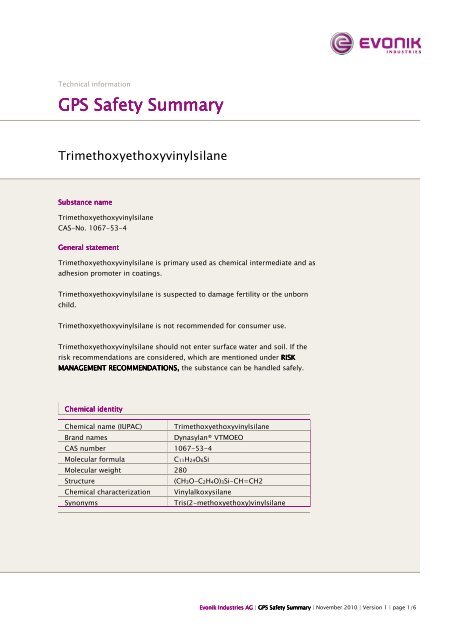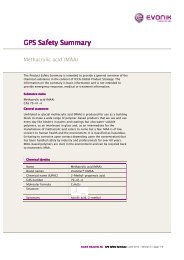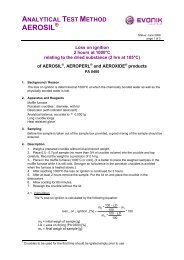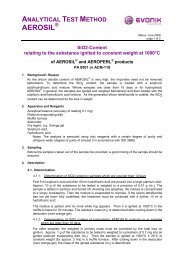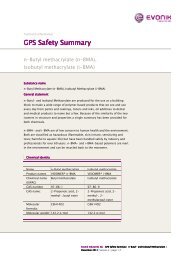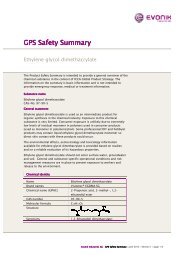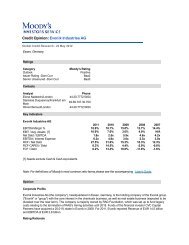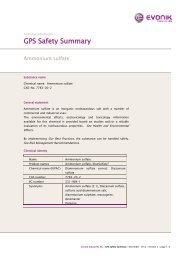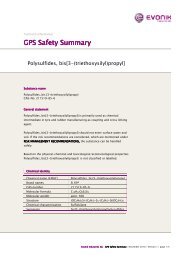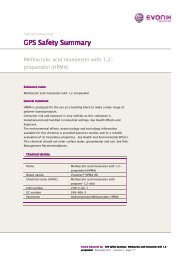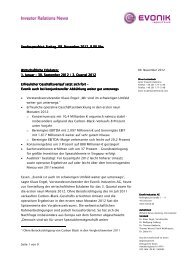trimethoxyethoxyvinylsilane GPS Safety Summary - Evonik ...
trimethoxyethoxyvinylsilane GPS Safety Summary - Evonik ...
trimethoxyethoxyvinylsilane GPS Safety Summary - Evonik ...
Create successful ePaper yourself
Turn your PDF publications into a flip-book with our unique Google optimized e-Paper software.
Technical information<br />
<strong>GPS</strong> <strong>Safety</strong> <strong>Summary</strong><br />
Trimethoxyethoxyvinylsilane<br />
Substance name<br />
Trimethoxyethoxyvinylsilane<br />
CAS-No. 1067-53-4<br />
General statement<br />
Trimethoxyethoxyvinylsilane is primary used as chemical intermediate and as<br />
adhesion promoter in coatings.<br />
Trimethoxyethoxyvinylsilane is suspected to damage fertility or the unborn<br />
child.<br />
Trimethoxyethoxyvinylsilane is not recommended for consumer use.<br />
Trimethoxyethoxyvinylsilane should not enter surface water and soil. If the<br />
risk recommendations are considered, which are mentioned under RISK<br />
MANAGEMENT RECOMMENDATIONS, the substance can be handled safely.<br />
Chemical identity<br />
Chemical name (IUPAC) Trimethoxyethoxyvinylsilane<br />
Brand names<br />
Dynasylan® VTMOEO<br />
CAS number 1067-53-4<br />
Molecular formula<br />
C11H24O6Si<br />
Molecular weight 280<br />
Structure<br />
(CH3O-C2H4O)3Si-CH=CH2<br />
Chemical characterization Vinylalkoxysilane<br />
Synonyms<br />
Tris(2-methoxyethoxy)vinylsilane<br />
<strong>Evonik</strong> Industries I<br />
AG | <strong>GPS</strong> <strong>Safety</strong> <strong>Summary</strong> | November 2010 | Version 1 | page 1/6
Uses and application<br />
Trimethoxyethoxyvinylsilane is used as a monomer in the production of<br />
silicone polymers or, more likely, silicone resins usually in combination with<br />
other organochloro- or organoalkoxy-silane monomers.<br />
The substance is used as a coupling agent (or adhesion promoter) to<br />
enhance or reinforce bonding between a polymer matrix and a filler in rubber<br />
and plastic manufacture.<br />
Trimethoxyethoxyvinylsilane is used as cross-linking agent and adhesion<br />
promoter in silicone sealant products for professionals.<br />
Physical/chemical properies<br />
Trimethoxyethoxyvinylsilane is a liquid at standard temperature and<br />
pressure. The substance is not classified as flammable on the basis of a flash<br />
point of 115°C. It self-ignites at 210°C, is not explosive and is not oxidizing.<br />
Property<br />
Value<br />
Physical state<br />
Liquid<br />
Color<br />
Colorless<br />
Density 1.03 g/cm 3 at 25 °C<br />
Melting / Boiling point -130°C at 1013 hPa / 285°C at 1013<br />
hPa<br />
Explosive Properties<br />
No explosive properties<br />
Self-ignition temperature 210°C at 1013 hPa<br />
Vapor pressure 0.43 Pa at 25°C<br />
Water solubility<br />
71g/l at 20°C, decomposition by<br />
hydrolysis<br />
Flash point<br />
115°C at 1013 hPa<br />
Octanol-water partition 0.3 at 20°C<br />
coefficient<br />
Viscosity 2.3 mPa s at 25°C<br />
<strong>Evonik</strong> Industries I<br />
AG | <strong>GPS</strong> <strong>Safety</strong> <strong>Summary</strong> | November 2010 | Version 1 | page 2/6
Health effects<br />
Trimethoxyethoxyvinylsilane is not harmful or toxic after single oral<br />
ingestion of high concentrations or single dermal contact. The substance is<br />
not irritating to skin and eyes and not a skin sensitizer. The available data do<br />
not support classification for toxicity after repeated intake of low<br />
concentration. Based on the available results Trimethoxyethoxyvinylsilane<br />
has not shown mutagenic or genotoxic effects and there is no evidence for<br />
carcinogenicity. 2-Methoxyethanol can be released from the substance. 2-<br />
Methoxyethanol is known to be toxic for reproduction in animals.<br />
Health effects<br />
Effect Assessment<br />
Acute toxicity (oral, dermal<br />
and inhalation)<br />
Eye / Skin irritation<br />
Sensitization<br />
Toxicity after repeated<br />
exposure<br />
Genotoxicity / mutagenicity<br />
Carcinogenicity<br />
Toxicity for reproduction<br />
Result<br />
not harmful or toxic<br />
not irritating<br />
not sensitizing<br />
Not toxic<br />
No mutagenic / genotoxic effects<br />
There is no evidence of carcinogenicity<br />
evidence of reproduction toxicity in<br />
animals<br />
Environmental effects<br />
Trimethoxyethoxyvinylsilane needs not to be classified as harmful or toxic to<br />
aquatic organisms. The substance is partial biodegradable and hydrolyzes<br />
very fast. Based on the bioaccumulation assessment (hydrolysis) and toxicity<br />
assessment (not classified for long-term human health effects or for aquatic<br />
toxicity) the substance does not meet the criteria for PBT or vPvB.<br />
Environmental effects<br />
Effect Assessment<br />
Aquatic toxicity<br />
Fate and Behavior<br />
Biodegradation<br />
Bioaccumulation potential<br />
PBT / vPvB conclusion<br />
Result<br />
Low toxicity to water organisms<br />
Result<br />
Partial biodegradable<br />
Not bioaccumulative<br />
Not considered to be either PBT nor<br />
vPvB<br />
<strong>Evonik</strong> Industries I<br />
AG | <strong>GPS</strong> <strong>Safety</strong> <strong>Summary</strong> | November 2010 | Version 1 | page 3/6
Exposure<br />
Human / Environment<br />
There is no exposure to humans from Trimethoxyethoxyvinylsilane via the<br />
environment, as the substance is highly reactive and, thus, immediately<br />
hydrolyzes. Manufacturing occurs under controlled conditions, with releases<br />
to air and waste water according to the existing legal and regional<br />
permissions. Releases to the environment during use and handling are<br />
limited by use of appropriate measures as mentioned in the <strong>Safety</strong> Data<br />
Sheet and described under Risk Management Recommendations. Due to the<br />
reactive nature of Trimethoxyethoxyvinylsilane when in contact with water, or<br />
indeed with silanols, under the conditions used to prepare silicone polymers<br />
and resins, it can be assumed that they are completely consumed in the<br />
hydrolysis/condensation process,<br />
In those cases where Trimethoxyethoxyvinylsilane in sealants is used in<br />
professional applications, the Silane has invariably hydrolyzed and<br />
condensed to form Siloxane oligomers and polymers and there is no<br />
exposure from the end product.<br />
Risk management recommendations<br />
Description<br />
General measures<br />
Specific Human Health risk<br />
management measures<br />
Specific Environment risk<br />
management measures<br />
Production and on site<br />
(i) Procedural and<br />
(i) Local Exhaust ventilation (LEV)<br />
(i) Use of air emission<br />
use (site specific)<br />
technological control using<br />
(ii) Personal Protective Equipment<br />
abatement equipments such<br />
Best Available Technique<br />
(PPE): Fluorinated or nitrile rubber<br />
as incinerators and scrubbers<br />
(BAT)<br />
gloves/gauntlets and protective<br />
(ii) Treatment of effluent in<br />
clothing<br />
biological waste water<br />
(iii) Specific workers’ training<br />
treatment plant<br />
(iii) Incineration of waste<br />
Intermediate, use as<br />
(i) Procedural and<br />
(i) Local Exhaust ventilation (LEV)<br />
(i) Treatment of effluent in<br />
monomer, non-metal<br />
technological control using<br />
(ii) Personal Protective Equipment<br />
waste water treatment plant<br />
surface treatment, non-<br />
Best Available Technique<br />
(PPE): Fluorinated or nitrile rubber<br />
(WWTP)<br />
aqueous polymer<br />
(BAT)<br />
gloves/ gauntlets and protective<br />
preparation. Use in<br />
clothing;<br />
rubber and plastics<br />
Suitable respiratory<br />
protective equipment should<br />
be worn if duration of<br />
exposure is greater than 15 min<br />
(iii) Workers’ training<br />
Industrial use of sealants<br />
(i) Procedural and<br />
(i) Butyl, nitrile, or neoprene<br />
(i) Treatment of effluent in<br />
technological control using<br />
gloves / gauntlets and protective<br />
waste water treatment plant<br />
Best Available Technique<br />
clothing;<br />
(WWTP).<br />
(BAT)<br />
(ii) Workers’ training<br />
Professional use of<br />
N/A<br />
(i) maximum product<br />
(i) Standard municipal WWTP<br />
sealants<br />
concentration of 0.4%; (ii) Butyl,<br />
nitrile, or neoprene gloves<br />
recommended<br />
<strong>Evonik</strong> Industries I<br />
AG | <strong>GPS</strong> <strong>Safety</strong> <strong>Summary</strong> | November 2010 | Version 1 | page 4/6
State agency review<br />
• EU-GHS Regulation (EU) No. 1272/2008<br />
• EU-Risk Assessment (Regulation 793/93)<br />
• EU REACH registration 2010<br />
• OECD SIDS Program<br />
Regulatory information/classification and labelling<br />
GHS-Labelling<br />
Statutory basis EU-GHS as per Regulation (EU) No. 1272/2008<br />
Symbol(s)<br />
Signal word<br />
Warning<br />
H361: Suspected of damaging fertility or the unborn<br />
child (H361f).<br />
Precaution statements and more information about Trimethoxyethoxyvinylsilane<br />
can be found in the <strong>Safety</strong> Data Sheet.<br />
<strong>Evonik</strong> Industries I<br />
AG | <strong>GPS</strong> <strong>Safety</strong> <strong>Summary</strong> | November 2010 | Version 1 | page 5/6
This <strong>GPS</strong> <strong>Safety</strong> <strong>Summary</strong> is based on <strong>Evonik</strong>´s present knowledge and experience as of the date of<br />
issue. However, it implies no liability or other legal responsibility on the part of <strong>Evonik</strong>, including<br />
with regards to existing third party intellectual property rights, especially patent rights. In no event<br />
shall <strong>Evonik</strong> be responsible for damages of any nature whatsoever resulting from the use of or<br />
reliance upon the information herein or the chemical to which that information refers. In particular,<br />
no warranty, whether express or implied, or guarantee in the legal sense is intended or implied by<br />
<strong>Evonik</strong>.<br />
This <strong>GPS</strong> <strong>Safety</strong> <strong>Summary</strong> is only intended to provide general information about the chemical<br />
referred to herein but not any in-depth health and safety information. The information in this <strong>GPS</strong><br />
<strong>Safety</strong> <strong>Summary</strong> is supplied on the condition that the persons receiving the same will make their<br />
own determination as to its suitability for their purposes prior to use. This <strong>GPS</strong> <strong>Safety</strong> <strong>Summary</strong><br />
does not supersede or replace required regulatory and/or legal communication documents.<br />
Performance of the chemical described herein should be verified by testing which should be carried<br />
out only by qualified experts.<br />
<strong>Evonik</strong> reserves the right to make any changes to this <strong>GPS</strong> <strong>Safety</strong> <strong>Summary</strong> in accordance with<br />
technological progress or further developments. Reference to trade names used by other<br />
companies is neither a recommendation, nor does it imply, that similar products could not be used.<br />
Glossary<br />
Acute toxicity<br />
Biodegradable<br />
Bioaccumulation<br />
Carcinogenicity<br />
Chronic toxicity<br />
GHS<br />
Mutagenicity<br />
PBT<br />
Reprotoxicity<br />
Sensitizing<br />
Teratogenic<br />
vPvB<br />
harmful effects after a single exposure<br />
breakdown of materials by a physiological environment<br />
accumulation of substances in the environment<br />
effects causing cancer<br />
harmful effects after repeated exposures<br />
Global Harmonized System on Classification and Labelling<br />
effects that change genes<br />
Persistent Bioaccumulative Toxic<br />
teratogenicity, embryotoxicity and harmful effects on fertility<br />
allergenic<br />
effects on foetal morphology<br />
very Persistent very Bioaccumulative<br />
Contact information within company<br />
Email address :<br />
sds-im@evonik.com<br />
Emergency Telephone number: +49 (0)7623 91-9191


